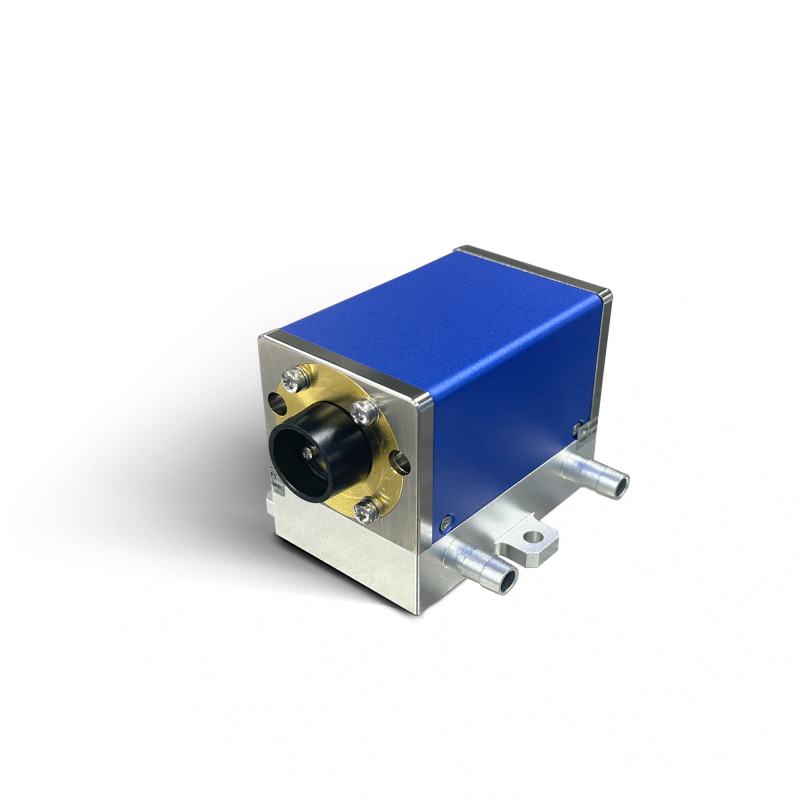CW DIODE PUMP Nd: YAG MODULE
Product Description
What is a CW DPSS laser? Definition Break-down
Continuous Wave (CW): This refers to the operational mode of the laser. In CW mode, the laser emits a steady, constant beam of light, as opposed to pulsed lasers which emit light in bursts. CW lasers are used when a continuous, steady light output is required, such as in cutting, welding, or engraving applications.
Diode Pumping: In diode-pumped lasers, the energy used to excite the laser medium is supplied by semiconductor laser diodes. These diodes emit light that is absorbed by the laser medium, exciting the atoms within it and allowing them to emit coherent light. Diode pumping is more efficient and reliable compared to older methods of pumping, like flashlamps, and allows for more compact and durable laser designs.
Solid-State Laser: The term “solid-state” refers to the type of gain medium used in the laser. Unlike gas or liquid lasers, solid-state lasers use a solid material as the medium. This medium is typically a crystal, like Nd:YAG (Neodymium-doped Yttrium Aluminum Garnet) or Ruby, doped with rare-earth elements that enable the generation of laser light. The doped crystal is what amplifies the light to produce the laser beam.
Wavelengths and Applications: DPSS lasers can emit at various wavelengths, depending on the type of doping material used in the crystal and the design of the laser. For example, a common DPSS laser configuration uses Nd:YAG as the gain medium to produce a laser at 1064 nm in the infrared spectrum. This type of laser is widely used in industrial applications for cutting, welding, and marking various materials.
Advantages: DPSS lasers are known for their high beam quality, efficiency, and reliability. They are more energy-efficient than traditional solid-state lasers pumped by flashlamps and offer a longer operational lifespan due to the durability of diode lasers. They are also capable of producing very stable and precise laser beams, which is crucial for detailed and high-precision applications.
→ Read more: What is Laser Pumping?
Key Applications of CW Diode Pumped Solid State Laser:
1. Laser Diamond Cutting:
The G2-A laser utilizes a typical configuration for frequency doubling: an infrared input beam at 1064 nm is converted into a green 532-nm wave as it passes through a nonlinear crystal. This process, known as frequency doubling or second harmonic generation (SHG), is a widely adopted method for generating light at shorter wavelengths.
By doubling the frequency of the light output from a neodymium- or ytterbium-based 1064-nm laser, our G2-A laser can produce green light at 532 nm. This technique is essential for creating green lasers, which are commonly used in applications ranging from laser pointers to sophisticated scientific and industrial instruments, and also be popular in the Laser Diamond Cutting Area.
2. Material Processing:
These lasers are extensively used in material processing applications such as cutting, welding, and drilling of metals and other materials. Their high precision makes them ideal for intricate designs and cuts, especially in the automotive, aerospace, and electronics industries.
3. Medical Applications:
In the medical field, CW DPSS lasers are used for surgeries requiring high precision, such as ophthalmic surgeries (like LASIK for vision correction) and various dental procedures. Their ability to precisely target tissues makes them valuable in minimally invasive surgeries.
4. Scientific Research:
These lasers are used in a range of scientific applications, including spectroscopy, particle image velocimetry (used in fluid dynamics), and laser scanning microscopy. Their stable output is essential for accurate measurements and observations in research.
5. Telecommunications:
In the field of telecommunications, DPSS lasers are used in fiber optic communication systems due to their ability to produce a stable and consistent beam, which is necessary for transmitting data over long distances via optical fibers.
6. Laser Engraving and Marking:
The precision and efficiency of CW DPSS lasers make them suitable for engraving and marking a wide range of materials, including metals, plastics, and ceramics. They are commonly used for barcoding, serial numbering, and personalizing items.
7. Defense and Security:
These lasers find applications in defense for target designation, range finding, and infrared illumination. Their reliability and precision are critical in these high-stakes environments.
8. Semiconductor Manufacturing:
In the semiconductor industry, CW DPSS lasers are used for tasks like lithograp, annealing, and the inspection of semiconductor wafers. The laser’s precision is essential for creating the microscale structures on semiconductor chips.
9. Entertainment and Display:
They are also used in the entertainment industry for light shows and projections, where their ability to produce bright and concentrated light beams is advantageous.
10. Biotechnology:
In biotechnology, these lasers are used in applications like DNA sequencing and cell sorting, where their precision and controlled energy output are crucial.
11. Metrology:
For precision measurement and alignment in engineering and construction, CW DPSS lasers offer the accuracy needed for tasks such as leveling, alignment, and profiling.
Application:Laser Diamond Cutting
Learn about the latest advancements in laser cutting technology.
Latest Diamond Cutting Laser: G2-A DPSS
Explore the 2023 Latest Diode Pumped Solid State Laser, and its application,strength,test report, etc.
Specifications
- Discover our comprehensive array of High Power Diode Laser Packages. Should you seek tailored High Power Laser Diode Solutions, we kindly encourage you to contact us for further assistance.
| Part No. | Wavelength | Output Power | Operation Mode | Crystal Diameter | Download |
| G2-A | 1064nm | 50W | CW | Ø2*73mm | Datasheet |
To Learn About Laser Diamond Cutting, 1. How were diamond cut before lasers?, 2. Challenge in Diamond cutting and sawing, 3. What are the advantages of laser cutting compared with traditional diamond cutting
Professional technical engineer dedicated to guide you
According to your actual needs, choose the most reasonable overall design and planning procedures
